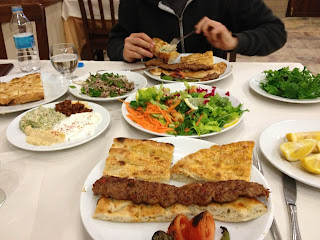The fertile crescent is home to virile soil and vivacious rivers and from this beginning humanity has emerged. Ancient cities abound in the area: Jericho, Jerusalem, Beirut, Aleppo, Amman and Alexandria; all testaments to the ages. Humans have lived in these cities for thousands of years, so yes, they're old. But not as old as Antep!
Gaziantep - Antep - is just north of the Syrian border with Turkey, in the country's far south-east ("Gazi," meaning war hero, was given to the city after its stoic defense against invading French troops). It is one of the oldest continually inhabited cities in the world, with few rivals - nearby Damascus is contested to be the oldest. Its lasting presence in the area is probably because it exists exactly where Mesopotamia ends and Anatolia begins. It is in this frontier that Gaziantep has prospered, outlasting the transiency of the Egyptians, the Phoenicians, the Romans, the Byzantines, the Seljuks, The Ottomans, and quite hopefully, the current Syrian regime.
 |
| Aleppo, Syria. |
It was to this regional stalwart we decided to go to wrap up our trip. Part of the reason was that Gaziantep followed our imaginary line through the middle of Turkey - kind of - and the other part was that we had heard something about food and something about dessert. Something about something delicious at least. It took a six hour train from Konya to get to Adana, where the good food started, and onward from Adana it took another four hours before we swung into Gaziantep.
 |
| Adana Kebap. |
 |
| Adana's mosque is the biggest between Turkey and Saudi Arabia. |
 |
| Hit one for four. Woulda hit them all but the sight was off! |
As the bus inched through Gaziantep's paralyzed traffic the following night, we were relieved to finally see the city's frantic bus terminal. As we shouldered our packs, crowds danced and sang to the beat of a drum in the darkness of the terminal's lot. It was a fitting introduction to a city full of energy and character, still holding onto the frontier of Anatolia.
We spent two days exploring the city, wading through fresh juice stands and baklava with two hands and an open mouth. The city's cuisine is reported to be the best in Turkey and is quite unlike the typical fare of heavy meats and bread. Instead, Gaziantep offered hundreds of dishes using things I've never tasted together before: walnut, pistachio, pomegranate, sour pomegranate molasses, yogurt, cucumber, tomato, zucchini and more.
 |
| Ali Nazik Kebap. |
But the city gets its fame for one thing: pistachios. Not just for the nut itself, which is sold by the kilo by vendors lining the city - but more so for pistachio baklava. It's not hyperbole when I say proper pistachio baklava is the BEST DESSERT IN THE WORLD. It's a phyllo layered pistachio sweet covered in a simple syrup but it is incredible. I don't even like dessert but this thing is out of this world. We went to the famed first shop in the city and the currently famous best spot in town and both were mind-blowing.
 |
| Pistachio baklava. |
 |
| Workers frantically pack baklava boxes to ship around the country. |
In between handfuls of baklava we went to the recently opened Mosaic Museum in Gaziantep. We arrived late and it had a steep entrance fee but man, those mosaics. 2000 year old mosaics laid out in full upon the walls or on the ground of the wide open museum space. It housed one of the most beautiful examples of a Roman mosaic still surviving; the Gypsy Girl, a mosaic of a fleeting girl with an unknown background. A copper bazaar rounded out the day as we squeezed through its narrow alleys, window shopping at beautiful carpets and metalwork that was way outside of our budget.
 |
| Tin and brass smith. |
 |
| Handmade leather shoes for sale. |
 |
| Making kitchen cookery. |
 |
| Pounds and pounds of spicy pepper flakes. |
***Before including Gaziantep in our itinerary, we spent hours flip flopping and fact checking to make sure it was safe and the nearby situation in Syria hadn't spilled over the border. Unfortunately, as a result of the conflict there are nearly 20 separate refugee camps lining the Turkish-Syrian border, but little indicators of the conflict in the city itself. The only negative thing we heard from a local was that "rent prices had gone up." The number of Syrian refugees outside of Syria - mostly in Lebanon, Turkey, Iraq and Jordan - just hit the 1 million mark and it was hard to fathom the immense suffering only an hour or two's drive away.

I've been looking forward to reading this post and it was worth the wait both for the gastronomical images and imagery as well as the history,geography and political commentary.
ReplyDeleteKeep on keepin'on !
Wow, an amazing way to round out what must have been a vacation of a lifetime! Two youthful travelers in an ancient region, rich with tastes, sights, smells and sounds! It must have been challenging to try to soak it all up. Music, mosaics, markets and Mosques, it sounds like a constant stream of external stimuli.
ReplyDelete